#astrakhan khanate
Text
The Decline of the Mongol Empire and the Birth of Russia
The Decline of the Mongol Empire and the Birth of Russia
A Map of Muscovy Russian Expansion from 1533-1598 Under Ivan the Terrible
Episode 31: Conversion and Assimilation
Barbarian Empires of the Steppes (2014)
Dr Kenneth Harl
Film Review
At its height the Mongol Empire consisted of four semi-independent states or hulas
The eastern hula, consisting of the Yuan Empire, Tibet and the Mongol homeland
The Chagatai Khanate on the central steppes
The Golden…
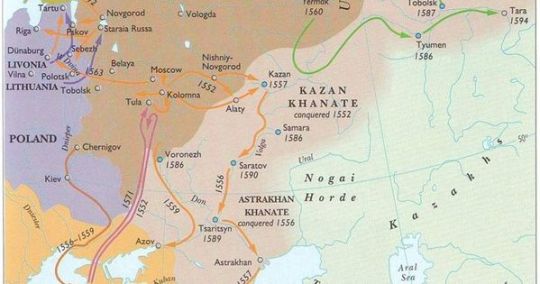
View On WordPress
#astrakhan khanate#battle of kurvo yeti#chagatai khanate#chu yuan-chang#cossacks#crimea khanate#golden horde#ilkhanate#ivan the great#ivan the terrible#kafia#kazan khanate#kublai khan#marmaluk sultans#ming dynasty#ottoman sultane#tamau#xanadu#yuan dynasty
0 notes
Text
Me as I’m researching Russia and Golden Horde: you mean I also need to learn about Rus principalities and politics at the time of Kievan Rus until Moscow? You mean I have to learn about the fall and division of Mongol Empire? Oh there are also Timurid Empire and Tamerlane too? The successor states of Golden Horde like Kazan Khanate, Astrakhan, Crimean Khanate, etc? What else?? Ottoman thrown into the mix too??
28 notes
·
View notes
Text
Russian Colonialism in Central Asia 1860-1890
From 1860 to 1890, Russia conquered Central Asia. What started as crafting a strong border along their Siberian territories grew into the conquest of most of modern day Central Asia.
Russia and Central Asia have a long, intertwined history that altered between coexistence and conflict. The Russians didn’t start expanding eastwards until the 1500s and they didn’t ’t really consider invading the region until the 1700s and even then, it’s contained to the Steppe lands. We don’t really see engagements with major Central Asian powers until the late 1700s/early 1800s. Their approach isn’t systematic or well planned. The Russians are responding to events unfolding, both in the region and from the around the world, as much as they are trying to shape events to fit their own priorities. They don’t fully subdue the region until the 1880s and roughly 30 years later WWI begins. By 1917 the Tsarist Empire collapses, and Russia loses all control over their conquered territories, including Central Asia. It would be up to the Bolsheviks and the various Central Asian republics to determine what relations would look like during the rest of the 20th century.
Early Russian Incursions (1580s-1700s)
As we mentioned, Russia and the various peoples of Central Asia traded and interacted with each other for most of their early history. The Russians did not consider expanding eastwards until the 1500s, starting with the overthrow of the Kazan khanate in 1552 and Astrakhan khanate in 1556 (two main centers of trade for people from all over the world). In 1580, they overthrew the Khanate of Sibr, opening up Siberia and introducing Kazakh peoples to Cossacks and Slavic merchants, and officials.
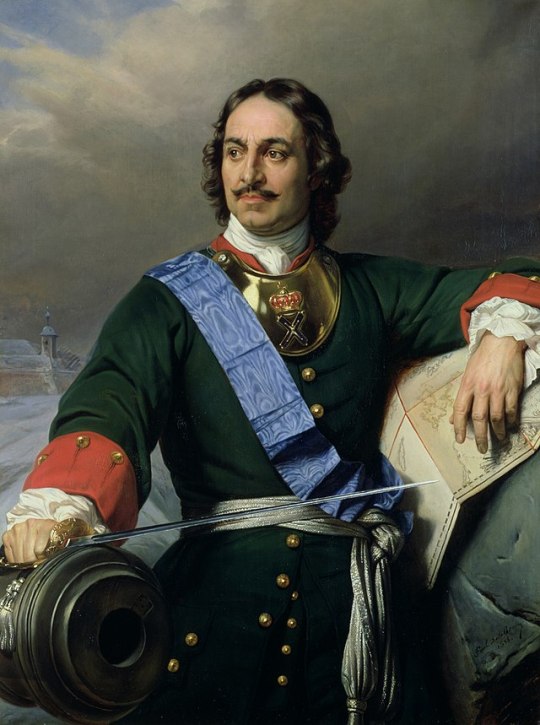
Peter the Great
[Image Description: A colored painting of a white man with curly brown hair and a mustache leaning against a chair. Behind him is a grey sky. The man is wearing a dark blue military frock coat with a light blue ribbon and a golden and green metal at his thought. His collar and cuffs are a bright red. He holds a sword with his right hand and a map with his left.]
Up until Peter the Great’s reign in 1682, the Russians and Central Asians spent their time learning about each other and establishing centers of trade. Neither saw each other as a source of danger since the Central Asians khanates were more concerned about fighting each other and resisting pressures from Safavid Iran and China whereas Russia was establishing itself as a state.
It was Peter the Great who turned Russia into an empire and pushed into the Central Asia region, sparking conflict with the Bashirs, Astrakhans, Khiva Khanate, and even Iran. Peter ordered several forts to be built along the current Kazakhstan border and took the Volga and Ural lands, encircling Central Asia. Their first proper incursion into the region was within Steppe lands. The Russians tried to implement tribute and oaths of loyalty, but the Kazakh people either resisted or manipulated Russian demands to fit their needs. They often played the Russians against their other enemies such as China, the Zunghar people, and the different Uzbek Khanates. However, the more involved they became with the Russians, the more restricted their political freedom became and by 1730 they officially asked the Russians for their protection.
Kazakhs and Kyrgyz peoples 1700s-1800s
The first Tsarina to truly interact with her Muslim subjects was Catherine the Great. She chose a position of tolerance while enforcing methods of police control. Catherine believed that if she could use the Islamic hierarchy to manage the people, she could instill law and order in the region. As long as she controlled who was recognized by the state as a legitimate source of religious authority, she could control the people and bind Islamic ideals to the Tsarist system. She implemented this policy with the Muslims in Siberia, the Volga and Ural regions, and the Crimea, utilizing the indigenous Tatars. When Russia tried to implement this system with the Kazakhs they ran into issues.

Catherine the Great
[Image Description: A colored painting of a white, big woman with grey hair pinned up and held in place by a golden crown. She is wearing a tan furred dress and a silver necklace with ornaments in the shape of snowflakes.]
Lack of knowledge is a key component in the Russian rule, and they were aware of this. As they incorporated the land, they sent several expeditions into the region to understand the territory, the people, and the benefits they could reap from the area. Ian W Campbell’s book Knowledge and Ends of Empire goes into great detail how much the Russians didn’t know as they conquered the Steppe lands and the efforts, they went through to fill in their knowledge gap.
Since the Kazakhs were nomads, they did not practice a type of Islam recognized by the Russians, so they were unable to utilize any existing religious structure, like they did with the Tatars. Instead, they had to engage with the different tribal leaders and indigenous informers and spies to manage the steppe peoples and enforce a form of sedentary lifestyle (with mixed results).
In an effort to “bring civilization” to the Kazakh people the Russians abolished the hordes and reorganized the land along tribal lines into three regions. They implemented a heavy bureaucracy consisting of auls, townships, and districts. In 1844, the Kazakhs traditional courts were stripped of authority over serious criminal cases and subjected Kazakhs to Russian military courts.
Authority was maintained by the Ministry of Foreign Affairs and military governors, which tried their best to manage the theft and abuse the Kazakhs and Kyrgyz peoples experienced from Russians officials and the Cossacks. This abuse seems to have been driven by the lawlessness common to vast frontiers (one can think of the US’s own Wild West as an example) and because most Russians looked down on the Kazakhs and Kyrgyz as inferior people.
Uzbek Khanates 1800-1900
Driven by mistreatment, starvation, and fear of the Russians, many Kazakh peoples found shelter in the Uzbek khanates. By the 1800s, all three khanates were experiencing civil wars and intense rivalries with each other and either ignored or were disinterested in the Russian encroachment. They were vaguely curious about the increase of British visitors but didn’t seem to realize that it meant trouble for their people. To be fair, the British were notoriously bad at trying to enlist the aid of the khanates as can be seen with the Conolloy-Stoddart-Nasrullah affair.

Nasrullah, Khan of Bukhara
[Image Description: An ink drawing of a man in a turban and long, wispy black beards. He also had a drooping black mustache and a white long dress shirt. The paper the painting is drawn on is tan and below the man are words written in Arabic]
Charles Stoddart was sent to Bukhara by the East India Company to win over the emirate, Nasrullah. Instead Nasrullah found him so insulting, he threw him into a bug pit for a few days. Stoddart remained in Bukhara for three years before the Company sent Captain Arthur Connolly to rescue him. Connolly traveled disguised as a merchant, but the Emirate was on alert since Britain was invading Afghanistan at the same time. Around the time Connolly was arrested, the Afghans organized a revolt that drove the British out of their country (only one British survivor made it back to India). Nasrullah wasn’t impressed and felt even more insulted by Connolly’s and Stoddart’s behavior, so he beheaded them when he caught them trying to smuggle letters to India.
Modern historians have poked several holes into the Great Game narrative, and it may be safe to say that the Great Game is more of a reflection of Britain’s own insecurities and fears than reality (with the Russians taking advantage of said fears). At the same time, Russia was feeling insecure compared to the other European states, had a need to make up for the humiliating defeat suffered during the Crimean War, were concerned about the security of their southern frontier, and held racist beliefs about the inferiority of the Central Asian peoples.
Their first attempt was to invade Khiva in 1839, but that ended in disaster. They would not try again until 1858, pushing southward, along the Syr Darya. By 1860 they had taken and established forts in what is modern day Almaty, Kazakhstan and Bishkek, Kyrgyzstan. In 1864 Colonel Mikhail G. Cherniaev finished the conquest of the land along the Syr Darya by taking the towns of Yasi and Shymkent. In 1865, he took Tashkent from Kokand, conquering the last bit of Kazakh land.
At this point, we can organize the Russian conquest around three major events: the subjugation of the Bukhara and Khiva Khanates, the abolishment of the Kokand Khanate, and the slaughter of the Turkmen people in the Ferghana valley
Conquering the Bukharan Khanate
However, conquering Tashkent dragged them into the rivalry between Kokand and Bukhara. The Russians wanted to turn Tashkent into a buffer state between themselves and Bukhara while Bukhara hoped the Russians would return the city to them. When Emir Muzzafar sent an envoy to embassy to the Tsar, he was arrested and Muzzafar was told he no longer had the right to speak to the Tsar directly. Muzzafar was stunned and furious so he arrested a Russian diplomat sent from Tashkent. The Russians attacked the Bukharan town of Jizza but returned from lack of supplies. The Bukharans responded by marching on Tashkent but were defeated by the Russians at Irjar. The Russians then took Khujand, cutting off communications between Bukhara and Kokand, preventing a coordinated resistance.

Konstantin Petrovich Von Kaufmann
[Image Description: A black and white lithograph of a white man with a receding hairline. He has a grey bushy mustache. He wears a grey military tunic with epaulettes and several medals. His hands rest on his shoulder hilt.]
To neutralized Kokand, further the Russians a treaty with Kokand granting Russian merchants free trade rights in the khanate and vice versa in Russian Turkestan. However, since Russia’s economy was bigger, this made Kokand an economic vassal.
Bukhara tried to resist the Russians but because of a divided military, internal rebellions, and antiquated technology, Muzzafar was forced to surrender in June 1868. The treaty restored Muzzafar’s sovereignty but took Samarkand away, controlling Bukhara’s main water source. Russian merchants were allowed to conduct business in Bukhara with the same rights as local merchants and Bukhara had to pay a compensation for Russia’s expenses during the war.
While the conquest of the Syr Darya basin and Tashkent had been approved by ministers in St. Petersburg, the Bukharan conflict was decided by officers on the ground. They actually recalled Cherniaev in 1866 only for his replacement, Romanovskii to attack Khujand. In 1867, Romanovskii was replaced by Konstantin Petrovich Von Kaufmann (who was a bit of an asshole) who served as Turkestan’s first governor-general. Despite the fact that its military had gone rogue, the Russians could not tolerate retreating or returning the land. Think about how it would affect its standing amongst the European powers (sarcasm)
Kaufman called his conquered territory Turkestan and made Tashkent as its capital. Given its distant from St. Petersburg, Kaufman enjoyed remarkable independence and was more like an emperor than a civil servant.
Conquering the Khivan Khanate
By 1859, Russia had conquered the North Caucasus and created a port in modern day Turkmenboshi, Turkmenistan. This allowed the Russians to transport goods via the river, instead of making the long and dangerous journey from Khiva to Orenburg. This deeply hurt Khiva’s income and cut into the incomes of the Turkmen who protected or raided the traveling merchants.
That, combined with the Russian conquest of Kokand and Bukhara and Khiva was in serious trouble. Khivan Emir Muhammad Rahim, learned from Bukhara, released all Russian prisoners, and negotiated with Russia for peace. Kaufman, however, wasn’t interested in peace. Instead, he sent message after message to Alexander II to complain about Khiva’s insolence and the danger it posed to Russian merchants, finally getting his permission to launch a military campaign to punish Khiva. In 1872, Kaufman led an invasion of four columns, consisting of over 12,000 men and tens of thousands of camels and horses and attacked Khiva from three directions. The Khivans did not resist vigorously whereas the Turkmen fought viciously.
On June 14th, Muhammad Rahim surrendered and Kaufmen forced him to govern under a Russian led council while he ransacked the palace for personal prizes. On August 12th, 1873, Rahim signed a stricter treaty then the one Muzzafar signed. The treaty forced the khan to acknowledge he was an obedient servant of the Tsar, granted control of navigation over the river Amu Darya to the Russians, and granted extensive privileges to Russian merchants. They also agreed to pay Russian 2.2 million rubles over the course of twenty years.
The Turkmen
While Khiva was subdued, the Turkmen were as rebellious as ever and Kaufman jumped at the opportunity to expand his power and earn more “glory”. In July 1873, he required that the Turkmen pay 600,000 rubles with only two weeks to deliver, knowing it would be impossible to do. When they failed, Kaufman launched an attack on the Yomut, a Turkmen tribe. American journalist Januarius MacGahan reported the following:
This is war such as I had never before seen, and such as is rarely seen in modern days…I follow down to the marsh, passing two or three dead bodies on the way. In the marsh are twenty or thirty women and children, up to their necks in water, trying to hide among the weeds and grass, begging for their lives, and screaming in the most pitiful manner. The Cossacks have already passed, paying no attention to them. One villainous-looking brute, however, had dropped out of the ranks and leveling his piece as he sat on his horse, deliberately took aim at the screaming group, and before I could stop him, pulled the trigger. Fortunately, the gun missed fire, and before he could renew the cap, I rode up and cutting him across the face with my riding-whip, ordered him to his sotnia. - Januarius MacGahan
By end of July, the Turkmen agreed to pay and Kaufman extended the deadline.
Even though Russian conquered Kokand, they had a hard time implementing political control, having to deal with a still strong khanate and an angry populace. The death of the old khan, Alim Qul, allowed Khudoyar Khan to return to rule. However, his close ties with Russia inspired a revolt amongst the Kokandi Kyrgyz nobles who drove him out in August 1875. The Russians placed his son, Nasruddin on the throne, but another revolt drove him out as well and Russia was stuck with a region deep in civil war with no clear factions.
Kaufman, worried that Bukhara or the British would take advantage, launched another military campaign. This campaign was particularly bloody, with Major-General Mikhail D. Skobelev making it a point of murdering civilians to crush all future rebellions. Vladimir P. Nalivkin, a young officer serving under Skobelev wrote the following of an incident where Skobelev ordered his Cossacks to charge fleeing civilians while their divisional commander countermanded the order. He then told Nalivkin to chase after a Cossack bearing down on an unarmed man carrying his child. Nalivkin wrote the following:
“With a cry “leave him alone! Leave him alone!” I rushed towards the man (sart), but it was already too late: one of the Cossacks brought down his sword, and the unfortunate two or three-year-old child fell from the arms of the dumbfounded, panic-striken man, landing on the ground with a deeply cleft head. The man’s arms were apparently cut. The bloody child convulsed and died. The man blankly stared now at me, now at the child, with wildly darting, wide eyes. God forbid that anyone else should have to live through the horror I lived through in that moment. I felt as though insects were crawling up my spine and cheeks, something gripped me by the throat, and I could neither speak nor breathe. I had seen dead and wounded people many times; I had seen death before, but such horror, such abomination, such infamy I had never been seen with my own eye: this was new to me.” - Vladimir P. Nalivkin
The war ended in 1876 with the bombing of Andijan, which Skobelev described himself as a pogram. Kaufman abolished the Kokand Khanate on February 19th, the same day as the anniversary of Alexander II’s ascension to the throne. He renamed the region the Ferghana District and named Skobelev its governor.
Finally, the Russians finished their conquest by subjugating the Turkmen Tekke tribes who lived around the oases in the Qara Qum desert. The reason for the attack was geopolitical. The Russians had won a war against the Ottoman Empire in 1878 but the British prevented the Russians from seizing Constantinople, so Kaufman was ordered to march on India.
Kaufman sent three columns towards Afghanistan and Kashmir and a fourth column heading towards the town on Kelif on the Amu Darya. To get there, they had to march through Tekke Turkmen territory. The attack was called off a week later, but the Russians continued south to establish a line of forts on the border of Iranian Khurasan. These forts were vulnerable to Turkmen attack, so the Russians laid siege to the town of Gok Tepe.
Their artillery was devastating but the Russians were defeated by fierce Turkmen fighting when they decided to storm the town. Skobelev led a revenge campaign in November 1880, finally blowing up the walls of Gok Tepe in January 1881. He ordered the Cossacks to pursue and kill anyone fleeing. The total cost was 14,500 Turkmen killed, including many non-combatants, destroying the Tekke Turkmen for decades and finalizing Russian control over Central Asia.
References
For Prophet and Tsar: Islam and Empire in Russia and Central Asia by Robert D. Crews Published by Harvard University Press, 2006
The Rise and Fall of Khoqand: Central Asia in the Global Age 1709-1876 by Scott C. Levi Published by the University of Pittsburgh Press, 2017
The Bukharan Crisis: a Connected History of 18th Century Central Asia by Scott C. Levi Published by University of Pittsburgh Press, 2020
Tatar Empire: Kazan’s Muslims and the Making of Imperial Russia by Danielle Ross Published by Indiana University Press, 2020
Russia and Central Asia: Coexistence, Conquest, Coexistence by Shoshana Keller Published by University of Toronto Press, 2019
Russia’s Protectorates in Central Asia: Bukhara and Khiva, 1865-1924 by Seymour Becker, Published by RoutledgeCurzon, 2004
Tournament of Shadows: the Great Game and the Race for Empire in Central Asia by Karl E. Meyer and Shareen Blair Brysac Published by Basic Books, 1999
#Season 2: Central Asia#Central Asia#Central Asian History#Russian Colonialism#Podcast Episode#Blog Post#history blog#queer historian#queer podcaster#Spotify
7 notes
·
View notes
Text
Before getting into the FUBAR that is Ivan the Terrible's reign, a brief look at Muscovite brideshows:
Before getting into the eight marriages of Ivan IV it's worth looking into how the old Grand Princes and earliest Tsars got married. This was one of many things that the Rus peoples of Moscow and Veliki Novgorod, those who became the Russians, inherited that those who became Belarusians and Ukrainians didn't. The Russians took this from the bridal customs of the Khans of the Golden Horde, a custom likewise retained in the Khanates of Siberia, Khazan, Astrakhan, and the Crimea after the unified state broke. The Brideshow offered plenty of room for intrigue and it lasted from the time the Princes of Moscow were able to declare themselves Grand Princes, and provided a particular backdrop to the establishment of Russian culture.
It was also part of a particular aspect of old Russia that likewise has been occluded, namely the concept of the Terem, which was very like a Harem but subject to much less Orientalist smut fantasies. Women were locked away in separate lives save when their husbands wanted their ashes hauled. This was also a heritage of the Khans.
#lightdancer comments on history#women's history month#europe and women's history#khanate of the golden horde#grand principality of moscow
0 notes
Text
Today, October 12, is Khater Kene. The day of mourning of Kazan Massacre of 1552 when Moskovian army attacked Kazan, the capital of Kazan Khanate, and Astrakhan, the capital of Astrakhan Khanate, looted the cities and killed its inhabitants.


1 note
·
View note
Text
Siberian History (Part 6): The Time of Troubles
By the late 1500s, Russia was one of the largest nations on earth. Its many principalities had been united by stealth & force under the reign of Moscow, and now that the Khanates of Kazan & Astrakhan on the Volga River had been subjugated, Russia was now a multinational state.
From Ivan the Terrible onwards, the tsar claimed to rule by “divine right”. This was already common in Europe, but the Russian tsar's power was autocratic and absolute. One contemporary wrote about Ivan, “like Nebuchadnezzar, he slew, had beaten, elevated, or humbled whomsoever he wished.”
The state bureaucracy was growing, and near the top was the Boyar Dumar, the royal council made up mostly of men of noble birth. There was also an inner cabinet of councillors, whom the tsar could consult. But it was said of Ivan that he often did so “in the manner of Xerxes, the Persian Emperor, who assembled the Asian princes not so much to secure their advice...as to personally declare his will.”
Russia had a population of about 13 million people, mostly impoverished peasants who worked on large estates, or worked their garden-like plots in tiny hamlets across the land.
The old aristocracy had been humbled somewhat, and the service gentry had arisen to take its place. The difference between the two was that the old aristocracy inherited their titles & land by inheritance, whereas the service gentry were awarded estates for service to the tsar. However, the service gentry would eventually acquire many of the prerogatives of the aristocracy, including titles and inheritable estates.
Russia had no true middle class, independent merchant guilds, or any mercantile economy of the sort that was beginning to grow in many European countries. The gosts (“great merchants”) were appointed by the Crown. All offices & positions were in the employ of the state, i.e. “state service”.
Travel within Russia was restricted, and travel abroad was almost unknown, “that Russians might not learn of the free institutions that exist in foreign lands.” Police surveillance was widespread, and people had the “duty to denounce” – no matter what rank or standing people had, they had to politically inform on each other, and report whatever they knew or heard about disloyal acts or thoughts.
Punishments were harsh, and torture was common. People could be torn to pieces with iron hooks, beheaded or impaled, branded with red-hot irons, have their limbs cut off, or beaten with the knout. The “knout” was a short whip with a tapered end, and attacked to this tapered end were three tongs of hard tanned elk hide, which cut like knives.
The roads were poor, and there were no inns between towns for travellers. Alcoholism was a major problem throughout the nation. There was little intellectual curiosity – even a simple knowledge of astronomy, such as the ability to predict eclipses, could lead to a charge of witchcraft.
One foreign diplomat said that the habit of oppression had “set a print into the very mindes of the people. For as themselves are verie hardlie and cruellie dealte withall by their chiefe magistrates and other superiours, so are they as cruell one against an other, specially over their inferiours and such as are under them. So that the basest and wretchedest [peasant] that stoupeth and croucheth like a dog to the gentleman, and licketh up the dust that lieth at his feete, is an intollerable tyrant where he hath the advantage.”
Foreigners saw the Russians as a semi-barbaric, insular people and state, arrogantly self-assured as the true bearer of Christianity, but rife with ignorance, supersitition and immorality. One visitor to Muscovy made up a rhyme about it:
Churches, ikons, crosses, bells, / Painted whores and garlic smells, / Vice and vodka everyplace – / This is Moscow's daily face.
To loiter in the market air, / To bathe in common, bodies bare, / To sleep by day and gorge by night, / To belch and fart is their delight.
Thieving, murdering, fornication / Are so common in this nation, / No one thinks a brow to raise – / Such are Moscow's sordid days.
But it was not as bad as foreigners claimed. The common people were genuinely religious, and a renaissance was taking place – through trade and other contracts, Western cultural influences were beginning to have an effect. These influences, combined with Russia's rich Byzantine heritage, might have brought about a true renaissance, but these currents would be overwhelmed by the bloody legacies of the immediate past.
Ivan the Terrible's tyrrany had divided the nation in two; and the social enmities he had created would outlive him. In 1581, he killed his eldest son, Tsarevich Ivan Ivanovich, during an argument. When he died himself in 1584, his son Fyodor succeeded him.
Fyodor I was absent-minded and reluctant to be monarch, and he relied heavily on the boyars appointed to be his guardians. Plots sprung up, a power struggle ensued, and Boris Godunov became the dominant figure behind the throne. Boris was a noble of Tatar origin, and his sister was married to Fyodor. Soon, he was recognized as Lord Protector (as the English called him), and the de facto head of state.
Under Godunov's reign, trade prospered, revenue increased, taxes decreased, and peace returned. Fugitive peasants returned to their homesteads, more arable land was cultivated, grain prices fell, and granaries recorded large surpluses. Construction increased, with stone walls around Moscow and Smolensk; many new churches, expanded port facilities at Arkhangel, and the completion of the Ivan the Great Belltower in the Kremlin, reaching upwards in three tapering octagonal tiers.
There was military progress as well. Godunov made headway against the nomadic peoples in the southern steppes (between Russia and the Crimea), established a series of important fortified towns, recoered territory lost to Sweden during the Livonian War, and pushed Siberian conquest eastwards from the Ob River.
When Fyodor died in 1598 without an heir, Godunov was offered the crown. He denied it three times, to demonstrate the inevitability of his succession, and looked to the masses for his support. At his coronation (in the Dormition Cathedral on September 1st, 1598) , he declared: “As God is my witness, there will not be a poor man in my stardom!” and tore the jewelled collar froms his gown. Jealous nobles called him Rabotsar, which means “the Tsar of slaves”.
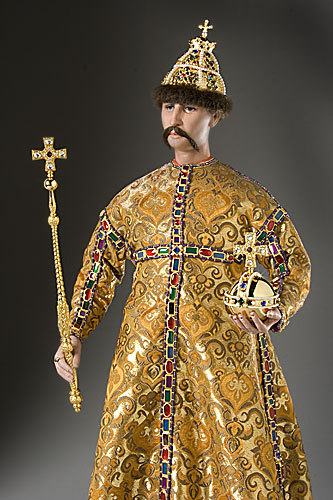
There are no known contemporary portraits of Godunov, but this is what he probably looked like.
After Godunov's coronation, favours were announced, army & administration officials received a substantial salary increase, merchants were granted tax breaks, and the natives of Western Siberia were exempted from taxes for a year. Godunov said: “We take a moderate tribute, as much as each can pay...And from the poor people, who cannot pay the tribute, no tribute is to be taken, so that none of the Siberian people should be in need.”
But this could not solve all the problems. The biggest problem was the competition among landed proprietors for peasants to work their estates. The more prosperous of them tempted peasants away from their smaller holdings. Many of these small holdings were held on military tenure, so their decline affected the security of the nation.
The government tried to solve this problem by binding the peasants to the soil. Peasants' freedom of movement had already been severely curtailed over the years, but now new decrees pushed them towards serfdom.
The service gentry squeezed everything they could from their peasants, who were already near breaking point because of state taxation. As a consequence, violence spread. In Russia's heartland, bands of highwaymen (who were once peasants) ransacked monasteries & manorial estates. Along the southern frontier, legions of the disaffected accumulated. Things were moving towards rebellion.
From 1601 – 03, protracted crops failures led to famine and mass starvation. Godunov distributed money and grain from the public treasury to those who were destitute, but widespread hoarding & profiteering by landlords & merchants (including the Stroganov family) not only negated his actions but made it worse.
Whole villages were wiped out. People ate cats, dogs and rats, as well as bark and straw. Human flesh was sold in public markets. An eyewitness wrote that every day in Moscow, “people perished in their thousands like flies on winter days. Men carted the dead away and dumped them into ditches, as was done with mud and refuse, but in the morning, “bodies half devoured, and other things so horrible that the hair stood up on end” could be seen. A court apothecary rescued a little girl from starvation, and entrusted her to a peasant family; he later learned that they had eaten her.
Thousands of unemployed labourers, and peasants abandoned to their fate by uncaring masters, scavenged throughout the countryside, or fled into the wilderness. This was the Time of Troubles, which lasted from 1598 to 1613.
It was beyond Godunov's control, and his standing fell. He was a legitimate tsar, properly elected; but he couldn't claim any dynastic link with Russia's “sacred” past. People soon began to see him as a ruthless usurper who had taken the throne through violence, crime and deceit. Rumours spread that he'd murdered Tsarevich Dmitry Ivanovich (Ivan the Terrible's 9-year-old son by his seventh wife); that he'd poisoned his own sister; that he'd poisoned Fyodor I himself. Godunov's spy network uncovered many plots, but discontent was still growing stronger.
There was an uprising in 1603 by peasants, fugitive slaves and bandits, which the army put a stop to. The people began to long for the protection of a “born tsar”, romanticizing even the worst parts of their past.
Then a rumour sprang up that Tsarevich Dmitry had miraculously survived his assassination, and was about to retake the throne. The pretender (known later as False Dmitry I) was backed by the Poles, and in October 1604 he crossed into Muscovy, leading an army of mercenaries and volunteers. This False Dmitry was conventionally ugly, “a strange and ungainly figure with facial warts and arms of unequal length”. He was a charismatic leader, and many people joined his cause. His army was over 16,000 men by November. Godunov, feeling helpless, turned to sorcery & divination to try and alter his fate.

False Dmitry I.
Godunov died on April 13th, 1605, from poison or a stroke. His wife and son were murdered within the next few weeks, and the Kremlin was stormed. False Dmitry I ruled for nearly a year, from June 10th, 1605, to May 17th, 1606.
Then he was toppled by Vasily Shuisky, who became Tsar Vasily IV. Shuisky had the right pedigree, but not popular support.
New uprisings and foreign invasions followed this. In June 1607, False Dmitry II, again backed by the Poles, advanced on Moscow. This led to Vasily IV's deposition in July 1610, and the installation of a Polish tsar, Vladislav I (he would later become King of Poland, in 1632).

Vasily IV (17th-century painting).
It seemed as if Muscovy would be partitioned. Russian popular armies rose up in the north and east, and advanced with patriotic fervour. On October 25th, 1612, the Polish garrison in the Kremlin capitulated, and the foreigners were driven out.
On February 21st, 1613, a national assembly elected a new tsar. This was Mikhail Fyodorovich Romanov (Mikhail I), the grand-nephew of Anastasia Romanova, Ivan the Terrible's first wife. The Time of Troubles then came to an end.
#book: east of the sun#history#military history#economics#poverty#classism#time of troubles#russia#khanate of kazan#khanate of astrakhan#kazan of sibir#poland#siberia#moscow#ivan the terrible#tsarevich ivan ivanovich#fyodor i#boris godunov#tsarevich dmitry ivanovich#false dmitry i#vasily iv#mikhail i
45 notes
·
View notes
Text
Tuesday 14 January 1840
9
1 55/..
fine morning – R at quite 10° at my bedhead and rather more than 9 ½ on the console next the opening window tho’ the little inside window not open last night (forgot it) and my head aches for it this morning – breakfast over at 11 10/.. – then wrote note to ‘Monsieur A. Marc Esquire’ compliments – will be obliged to him to cash the enclosed circular – (no. 8590= £25) in notes of the smallest amount he may happen to have by him – then wafered and directed my letter (vid. Sunday written on the day but dated yesterday vid. p. 14 bis et seq.) to ‘Lady Vere Cameron Balkaskie [Balcaskie] Pittenwean [Pittenweem] Fife N.B. Escosse’ and sent this and my note at 11 ¾ (Gross said it was 12) by Gross to Mr. Marc – at 12 ¼ sent off George with note to ‘Madame la Comtesse A. Panin’ au désespoir at being always out when count P- calls – can he come today or tomorrow – should like to see the tarentass – will she be at home tomorrow evening? – Vid. St. James’s chronicle from 23 to 26 November p. 2 col. 1
Intelligence from Anapa and Tiflis viâ Odessa of the 4th instant .:. letters must go from O- to London in 3 weeks or less – Russian cavalry along the whole line of the Sundja and on the plains of Aiazan (or Alazan?) lost 3600 men – Soukorn, Kale, Anapa, and other fortified places resorted to – They say,
that the Circassian chief Szamhali is advised by several English and Polish officers – General Grabbe (commander in chief) of the army of the Caucasus has withdrawn all this Cossacks within fortresses and entrenched camps, and left the open country to the Circassians – Daghestan, except a few strong fortresses, has been evacuated – In Georgia and the 2 Kabaradahs the autumnal fever has been so severe among the troops that General Golovine has applied for reinforcements – cannot be spared from the army of the Crimea – here and all along the Black sea military preparations are still making upon the largest scale –
vid. St. James’s chronicle from 26 to 28 November p. 3 col. 1 Paris 26 November ‘the Sud of Marseilles says that the Egyptian question once settled, the great powers should attend to the European question and ‘prevent the renewal of the treaty of Unkiar Skelessi which would expire in June next, and to throw open the Black sea to vessels of all nations’
vid. St. James’s chronicle from 15 to 17 8ber. p. 3 col. 1’several other officers, implicated in the conspiracy discovered among the troops of General Geismars’ corps, had been arrested in St. Petersburg ‘i.e. of the Hussars of the Guard, and 12 of the division of Cuirassiers – the cabinet of St. P- supposed to have ‘some secret views with regard to Persia. A large military force had been of late on the march for the Khanats of Erivan and Shirvan, and orders had been forwarded to Astracan [Astrakhan] to arm the flotilla of the Caspian sea, which was lying in the roads of Linkoran and Bakou [Baku]’ – the question of mixed marriages
likely to give trouble in Russia as well as Prussia – the Roman catholic bishop of Augustowa in a recent pastoral letter has forbidden them – vid. p. 2 col. 3 the Commerce Paris paper gives the following resumé of the objections of reach of the 4 Powers ‘what does Russia want? to invade the Ottoman Empire.
what does England want? to overthrow the Egyptian power
what does Austria want? to prevent the invasions of the Ottoman empire by Russia and the overthrow the viceroy §
what does France want? to maintain the Egyptian power, to defend the Ottoman Empire, and to prevent collision’ –
§ that is of Egypt mehemet Ali.
vid. from 17 to 19 October p. 1 col. 5. Repair of footpaths – It is hoped the Surveyor would immediately attend to any proper application, but if not, it is provided by 5 and 6 William IV. c. 50, sect. 94. that any person may lay an information before a justice if a highway (which includes a footpath) is not ‘in thorough repair’ the information may be made before any justice, but must be upon oath, and sixpence, and no more, can be demanded for it by the clerk. this being done, the informant has nothing further to do. the act requires the justice to issue a summons to the surveyor to appear at the special sessions for the highways; at which sessions the justices either [?] a person to view the highway [complained] of, or they view it themselves, and then at the next sessions they adjudicate and must
SH:7/ML/E/23/0179
fine party, and compel the repair. Newcastle-on-Tyne, October 12, 1839’
p. 2 col. 6 Manchester and Leeds Railway ‘open to Rochdale and to Littleborough, at the extremity of that extensive parish, at the foot of Blackstone edge, ten miles due east from Manchester; from this part it bears north to skirt the mountain parallel with the Rochdale canal and the river at Todmorden the valley is so narrow as to be wholly taken up by the turnpike road, canal, and river; consequently the railway si tunnelling under the slope of the hill for 3080 yards, in one place 380ft. below the surface From Sowerby Bridge to Grelland (Great land?) the viaducts of the railway, the canal, and the river Calder, together with the luxuriant groves and pastures on the sides of the hills which hem in the valley, and the hundred factories interspersed, make up a picture which painting and poetry will never fully portray.’ Entire length of line from M- to Leeds terminus is 60 miles. 50 [?] while the mean distance is only 35 miles;’ it is however, the Manchester and Wakefield rather than the M- and Leeds Railway in as much as it falls into the great line from London to Leeds, diverging from the London and Birmingham at Rugby, by Derby, Chesterfield, Sheffield, etc. at Warmfield Heath, 2 miles east of Wakefield and about 10 SSE. of Leeds’ chronicle takes the above from a letter published in the Times
p. 3 col. 2 accident on the Versailles railroad likely to lead to the ruin of the undertaking ‘the banks and road, badly constructed of very improper materials, have given way........... this is not an ordinary accident, the result of a little oversight, but is the consequence of the railroad being badly made........ It is now discovered that the terrassing work has been very badly done throughout the whole line.’ !
had just written so far of today at 1 ¾ - having just before received kind note in answer from Countess Panin she will give my message to count P- and ‘he will do of his best to be with you at the appointed time’ – and Mr. Marc not at home but his partner opened my note – and sent me back the money – 5/. postage of my letter to Lady V.C. which will go today – then busy about 1 thing or other till now 2 5/.. – out at 2 20/.. – A- and I walked an hour (3 turns) small drizzling frozen mist all the while – then to Semens’ for little black books – had none – should go chez Bekker, or Junker, or Léon – went to the 1st – let the carriage follow and walked – arrived on foot .:. the young man not very polite – little black books worth 8d. (dear at Whitleys’) 2 roubles here – home at 3 40/.. – had Mrs. Howard with the carriage mans’ bill for 3 months at 450/. I having struck out the 40/. extra charged for our 3 little goings into the country -
Mrs. H- sure he knew nothing about the demand of 160/. for Troitsa on our arrival – she said all laquais de place would add a little – the man will now take us in one day for 80/. and in 2 days for 50/. deducting our 2 days or one day of town carriage pay, that is deducting 15/. or twice that .:. 2 days for 50/. – 30/. = 20/. that we ought to pay extra – this is worth thinking of [2 lines crossed] A- and I walked about the rooms a little while – had just written the last 13 lines now at 5 ¼ p.m. – wrote out a little of accounts – dressed – dinner at 6 ¼ to near 7 – Had Matrona and George to interpret – Read Schnitzler articles [?]-Novgorod etc. till now 7 40/.. – Had told Matrona thro’ George that she must help Grotza to wash the small things tomorrow – asked if she would do all she could – yes! if she liked the thought of leaving her country – yes! she had nobody here – all places would be alike to her – the girl said she would do whatever we told her and behaved very well – at 7 40/.. wrote the last 5 lines – then writing out accounts till had Grotza at 11 ¼ - then till 1 at my accounts finished writing all out up to tonight – small snow drizzling day but yet good walking – R10 ¾° on my table and 10 ¾ on the console now at 1 tonight R -9° at 8 a.m. out of doors and R -9 ½° on the boulevard in the snow while we were walking at 3 p.m.
4 notes
·
View notes
Text
The Khanate of the Golden Horde

After Genghis Khan's death, his united Mongol Empire quickly fragmented. One of the four main successors to the united Mongol Empire was the Khanate of the Golden Horde to the northwest. Its land today covers much of central and eastern Russia, as well as the south to the Caucasus Mountains and the Black Sea.
Also known as the Kipchak Khanate, and the Ulus of Jochi, it was given to Jochi, the eldest son of Genghis Khan. Unfortunately Jochi died several months before his father. So Jochi's son, Batu Khan, got inherited the territory. Under the new khan, the Golden Horde khanate expanded into Europe, subjugating the Russian principalities as they swept eastwards.
The Golden Horde khanate flourished until the middle of the 1300s, after which it began to decline. And it really fell apart after the invasion by Timur in 1396. By 1400, the Golden Horde fragmented into a number of smaller khanates, three of the most important being the Khanates of Crimea, Astrakhan, and Kazan.
326 notes
·
View notes
Text
Nations, and children
For many nations, birth of children is a death sentence to the extent that it becomes a rule more often than not. There are indeed nations who exist in the same time period as their children, but this doesn’t dismiss the presence of danger lurking in both the nation and the child’s lives as long as they do. Only when they have fulfilled the requirements and settled upon certain agreement to maintain balance that they’re able to coexist peacefully.
Children, for nations, mean disunity and separation. It is akin to one’s limb suddenly gaining a mind of its own and ripping itself out. It means that they no longer have the same consciousness and wants that they wish to go separate ways. It is in many ways like a separatist movement of any given country — something like this is NEVER desired and is always meant to be quelled. No country wants to lose a piece of themself. Even more dangerous considering that children of nations will be born no matter the wish of their parent; a country can’t prevent one from forming as much as they can’t will for one to be born. This makes it especially dangerous.
Many nations are on their way to hell the moment children arise in their land; for example Golden Horde, whose death was on the cards the moment small Khanates were born in his territory like Crimean Khanate, Kazan, Astrakhan, Nogai, Uzbek and Kazakh, you name it. They might carry his legacy but they no longer wish to go in the same direction as their parent did: they had their own government, their own interests, as well as their own identity. Ultimately Golden Horde’s territory was reduced to a rump state and eventually disappeared as he dwindled in importance and was no longer acknowledged by everyone else. This is the reality of any country.
Mongolia too didn’t exactly have a good time when his first four brats — Golden Horde, Chagatai, Ilkhanate and Yuan — were born. After all, they ripped his territory up in order to establish their own. He loved them but there was always the desire to absorb them back IF he had the power to do so — and his children knew it well, and might wish to absorb Mongolia into themselves as well IF they too had the capability. This is the reality of relationships between a parent nation and his children; never think of it as a wholly fun one.
Mongolia, however, was lucky. One of his children, Yuan, latched onto him for legitimacy and in turn he latched onto Yuan — and China — for literal life energy. Yuan and China made him stronger and thus he was able to contend with his other children. The divisions of Mongol Empire indeed never coexisted peacefully and were always in some sort of competition and territory-taking. Consequently, Mongolia, Yuan and China who were literally one were also in a precarious balance and tension to try swallow each other. But Mongolia had no complain because if it were not for them his other children would rip him up. For them, Mongolia was dangerous.
Now Mongolia has other child(ren) but things are mostly okay because they have reached upon an agreement for coexistence and cooperation. Bayan-Ulgii, who is a province, is Mongolian in every sense of the word and thus Mongolia could be stable. But he is also Kazakh, and so, what if Kazakhstan wants him back? What if Bayan-Ulgii wants to be part of Kazakhstan? There is no real worry about this thankfully though, because Mongolia and Kazakhstan are generally sane and well behaved with each other. But now you have the idea why children could be a bad idea for nations, even though if dealt well they could help their parent nations tremendously!!
#hetalia#aph mongolia#hws mongolia#oc kazakhstan#hws kazakhstan#aph china#hws china#oc golden horde#hws golden horde#oc yuan dynasty#hws yuan dynasty#my headcanon
9 notes
·
View notes
Photo
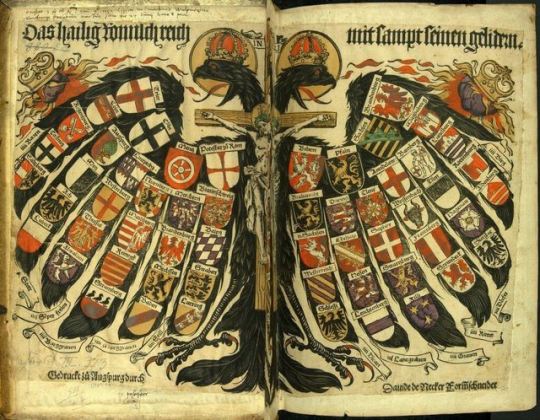





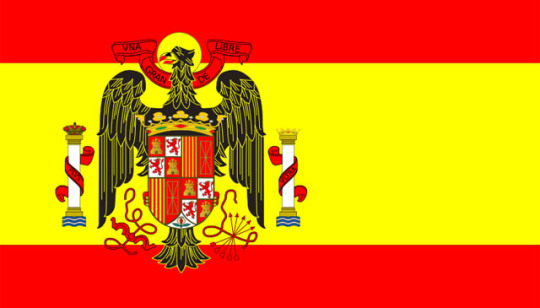



“The earliest depiction of the double-headed eagle can be found on ancient on Hittite monuments in central Anatolia. In the early 19th century, in Boğazkale, an old Hittite capital in modern-day Turkey...The double-headed eagle motif originally dates from c. 3800 BC. The Hittites had worshiped the double headed eagle as the King of Heaven, who was also called the Hittite Bird of the Sun. The bird was their symbol to signify Hittite military power.”

”The bird bird appears in Lygash under the name of Imgig, and was the Sumerian symbol for the god of Lagash, Ninurta son of Enlil...the double-headed eagle, however, is not restricted to supporting deities, and also appears supporting human figures. This is an indication of the use of the eagle as a personal (or family) symbol...The Seliuk Turks referred to it as Hamca and among the Zuni it appeared as a highly conventionalized design, but still as a double-headed thunder bird, the Sikyatki.”

”The double-headed eagle has been used as an emblem by countries, nations, and royal houses in Europe since the early medieval period. Notable examples include the Byzantine House of Palaiologos, the Holy Roman Empire, the House of Habsburg, and the Ruriks and Romanovs of Russia. The symbol often appears on countries’ coats of arms and flags. The emblem was adopted by the Russians, Poles, Serbians, Prussians, Austrians and Saxons. It was used as a private seal and as arms in Germany, Spain, France, Netherlands, England, and Russia.”
(via Mystery Of The Ancient Double-Headed Eagle Symbol | Locklip)
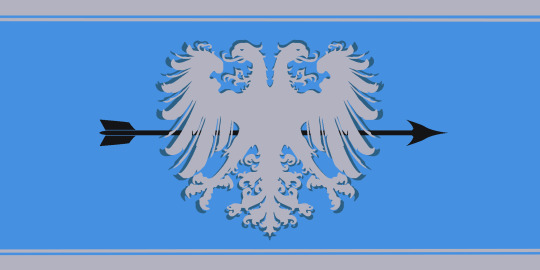
Double Headed Eagle iconology of Byzantium
“Greek scholars have tried to make links with ancient symbols: the eagle was a common design representing power in ancient city-states, while there was an implication of a "dual-eagle" concept...However, there is virtually no doubt that its origin is a blend of Roman and Eastern influences. Indeed, the early Byzantine Empire inherited the Roman eagle (extended wings, head facing right) as an imperial symbol.”

“[T]he church of Greece kept, and is to this date still using Byzantine flags with the eagle, usually black on yellow/gold background. But after the Ottoman conquest this symbol also found its way to a "new Constantinople" (or Third Rome), i.e. Moscow. Russia, deeply influenced by the Byzantine Empire, saw herself as its heir and adopted the double-headed eagle as its imperial symbol. It was also adopted by the Serbs, the Montenegrins, the Albanians and a number of Western rulers, most notably in Germany and Austria.”
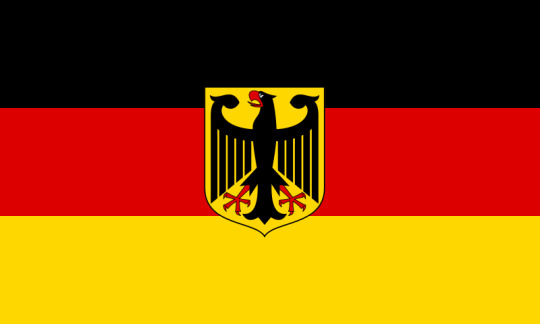
“The first mention of a double-headed eagle in the West dates from 1250 in a roll of arms of Matthew of Paris for Emperor Friedrich II. Theodore II Laskaris chose it for his symbol as Emperor (Empire of Nicaea), taking it to symbolize his state's claims to all the Byzantine Empire's former domains, both European (West) and Asian (East)... After the recapture of Constantinople and the restoration of the Byzantine Empire, the symbol was used as an emblem of the imperial family, but it is uncertain whether it was the official emblem of the Empire.”

“The double-headed eagle became the standard of the Seljuk Turks with the crowning of Toghrül (meaning "Eagle") Beg at Mosul in 1058 as "King of the East and the West" and was much used afterwards. The Sultans of Rum, Ala ad-Din Kay Qubadh I (1220-1237) and his son Kay Khusrau II (1237-1246) used the bicephalous eagle in their standards, and the motif was also found on tissues, cut stones, mural squares, and Koran holders.”
(via Double Headed Eagle iconology of Byzantium | Kythera Family blog)

The double-headed eagle of the Third Rome
“When looking carefully, you can distinguish 9 coats of arms on the eagle. However, in most cases, these shields are printed so tiny that few details can be revealed. The center shield on the eagle's chest is the one with the arms of Moscow. Then, in clockwise order starting from the heads, we see the arms of [Khanate of] Astrakhan, [Khanate of] Siberia, [Kingdoms & Principalities of] Georgia, [Grand Duchy of] Finland, [Grand Principalities of] Kiev-Vladimir-Novgorod, [Khanate of] Taurica, [Kingdom of] Poland and [Khanate of] Kazan...this double-headed eagle represents about 500 years of Russian imperial history.”
(via The double-headed eagle of the Third Rome | Franky’s Scripophily BlogSpot)
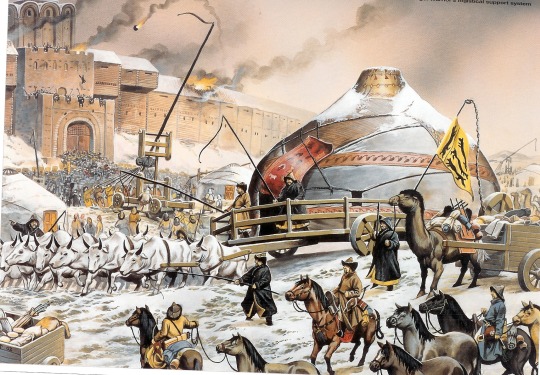
Kiev and the Byzantine Legacy in Russia
“The history of Kiev begins under the rule of the Rus. The Rus (also known as Varangians) were original Vikings who began to trade along the Volga River and later the Dnieper River. They establish several principalities centered on cities like Novgorod and later Kiev...Vladimir was also among the rulers of Kiev who gave military assistance to the Byzantines, leading to the formation of the Varangian Guard...Saint Sophia's Cathedral in Kiev, which dates to the early 11th century. It was designed rival Hagia Sophia in Constantinople, thus symbolizes Kiev as the 'new Constantinople'. There was even a Golden Gate in Kiev, named after the famous Golden Gate of Constantinople. In addition, the Kiev Monastery of the Caves date to 1051 and were influential in the spread of Orthodox thought.“
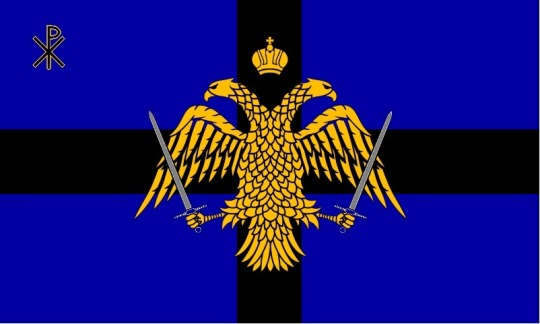
“As the Byzantine Empire was slowly dying, Moscow began to grow in power. The Metropolitan of Kiev moved to Moscow in the 14th century as the Tatars undermined the power of Kiev. Ivan III (1440-1505), the Grand Prince of Moscow, ended the dominance of the Golden Horde in Russia, and became to expand his own power. In 1472, He married Sophia Palaiologina, the niece of the last Byzantine Emperor, after the fall of Constantinople. He would then claim that Moscow was the “Third Rome” and by the end of the 16th century, the Metropolitan of Moscow claimed the title of patriarch. The title Tsar also reflects this claim to be the successor of Constantinople. In fact, the Russian Empire’s symbol was the Byzantine Double Eagle until the Soviet’s overthrew Tsar Nicholas II. This symbol has since returned after the fall of the Soviet Union.“

Mongol-Papal Encounter: Letter Exchange between Pope Innocent IV and Güyük Khan in 1245-1246
“By the late 1230s, Mongol armies had begun raiding parts of Russia and eastern Europe. Between 1236 and 1242, these military campaigns–commanded by Subutai (d. 1248), Batu Khan (d. 1255), and Berke (d. 1266), among others–had wrought major devastation across Russia, Poland, Hungary and the Balkans. The cities of Kiev, Pereyaslavl, Chernihiv, Lublin, and other major population centers in eastern and central Europe were sacked and their populations massacred.”
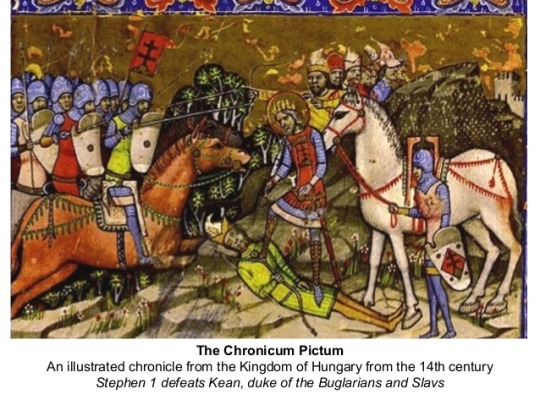
“The defeats of the Polish forces at the Battle of Liegnitz/Legnica (April 9th 1241) and the Hungarian military at the Battle of Mohi (April 11th 1241) opened up most of the Balkans and Central Europe to Mongol raids, leading to even more destruction, displacement and massacres. These alarming developments shook the foundations of Latin Christendom. Although the Mongols withdrew from most of the Balkans and east-central Europe soon after”
(via Mongol-Papal Encounter: Letter Exchange between Pope Innocent IV and Güyük Khan in 1245-1246 | Ballandalus blog)
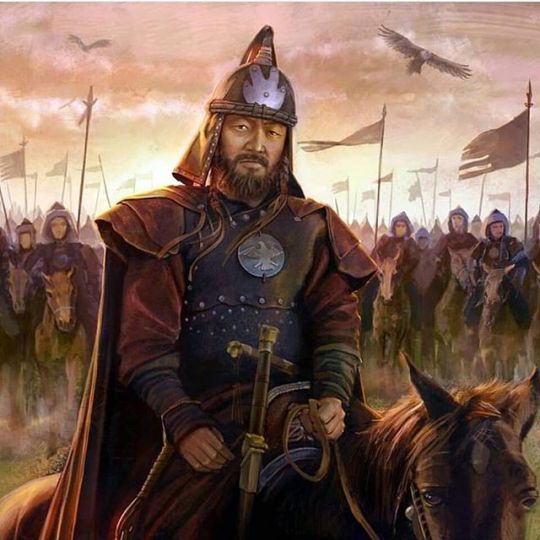
Borjigin
“A Borjigin or Borjigid is a member of the sub-clan, which started with Yesugei (but the Secret History of the Mongols makes it go back to Yesugei's ancestor Bodonchar), of the Kiyat clan. Yesugei's descendants were thus said to be Kiyat-Borjigin. The senior Borjigid provided ruling princes for Mongolia and Inner Mongolia until the 20th century. The clan formed the ruling class among the Mongols and some other peoples of Central Asia and Eastern Europe.”
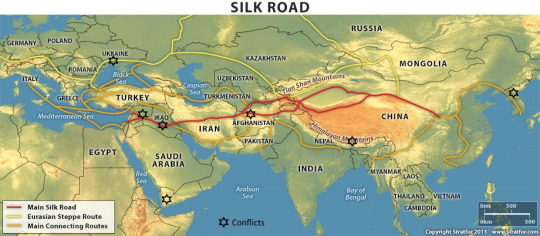
“The Borjigin family ruled over the Mongol Empire from the 13th to 14th century. The rise of Genghis (Chingis) narrowed the scope of the Borjigid-Kiyad clans sharply. This separation was emphasized by the intermarriage of Genghis's descendants with the Barlas, Baarin, Manghud and other branches of the original Borjigid.”

”In the western regions of the Empire, the Jurkin and perhaps other lineages near to Genghis's lineage used the clan name Kiyad but did not share in the privileges of the Genghisids. The Borjigit clan had once dominated large lands stretching from Java to Iran and from Indo-China to Novgorod. In 1335, with the disintegration of the Ilkhanate in Iran, the first of numerous non-Borjigid-Kiyad dynasties appeared. Established by marriage partners of Genghisids, these included the Suldus Chupanids, Jalayirids in the Middle East, the Barulas dynasties in Chagatai Khanate and India, the Manghud and Onggirat dynasties in the Golden Horde and Central Asia, and the Oirats in western Mongolia.In 1368, under Toghun Temür, the Yuan dynasty was overthrown by the Ming dynasty in China but members of the family continued to rule over Mongolia homeland into the 17th century, known as the Northern Yuan dynasty.”

“After the breakup of the Golden Horde, the Khiyat continued to rule the Crimea and Kazan until the late 18th century. They were annexed by the Russian Empire and the Chinese...The Qing dynasty respected the Borjigin family and the early emperors married the Hasarid Borjigids of the Khorchin. Even among the pro-Qing Mongols, traces of the alternative tradition survived. Aci Lomi, a banner general, wrote his History of the Borjigid Clan in 1732–35. The 18th century and 19th century Qing nobility was adorned by the descendants of the early Mongol adherents including the Borjigin.”

“Genghis Khan founded the Mongol Empire in 1206. His grandson, Kublai Khan, after defeating his younger brother Ariq Böke, founded the Yuan dynasty in China in 1271. The dynasty was overthrown by the Ming dynasty during the reign of Toghaghan-Temür in 1368, but it survived in Mongolia homeland, known as the Northern Yuan dynasty.”

Bahri dynasty
“The Bahri dynasty or Bahriyya Mamluks was a Mamluk dynasty of mostly Cuman-Kipchak Turkic origin that ruled the Egyptian Mamluk Sultanate from 1250 to 1382. They followed the Ayyubid dynasty, and were succeeded by a second Mamluk dynasty, the Burji dynasty."
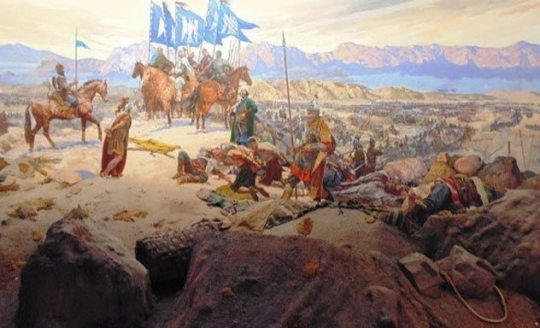

Burji dynasty
“From 1250 Egypt had been ruled by the first Mamluk dynasty, the mostly Cuman-Kipchak Turkic Bahri dynasty. In 1377 a revolt broke out in Syria which spread to Egypt...Barquq was proclaimed sultan in 1382, ending the Bahri dynasty...Permanently in power, he founded the Burji dynasty.”

House of Borghese
“Borghese is the surname of a princely family of Italian noble and papal background, originating as the Borghese or Borghesi in Siena, where they came to prominence in the 13th century holding offices under the commune. The head of the family, Marcantonio, moved to Rome in the 16th century and there, following the election (1605) of his son Camillo as Pope Paul V they rose in power and wealth. They were one of the leading families of the Black Nobilityand maintain close ties to the Vatican.”

Guelphs and Ghibellines
“The Guelphs and Ghibellines were factions supporting the Pope and the Holy Roman Emperor, respectively, in the Italian city-states of central and northern Italy. During the 12th and 13th centuries, rivalry between these two parties formed a particularly important aspect of the internal politics of medieval Italy.”

”The names were likely introduced to Italy during the reign of Frederick Barbarossa. When Frederick conducted military campaigns in Italy to expand imperial power there, his supporters became known as Ghibellines (Ghibellini). The Lombard League and its allies were defending the liberties of the urban communes against the Emperor's encroachments and became known as Guelphs (Guelfi). The Ghibellines were thus the imperial party, while the Guelphs supported the Pope. Broadly speaking, Guelphs tended to come from wealthy mercantile families, whereas Ghibellines were predominantly those whose wealth was based on agricultural estates.”
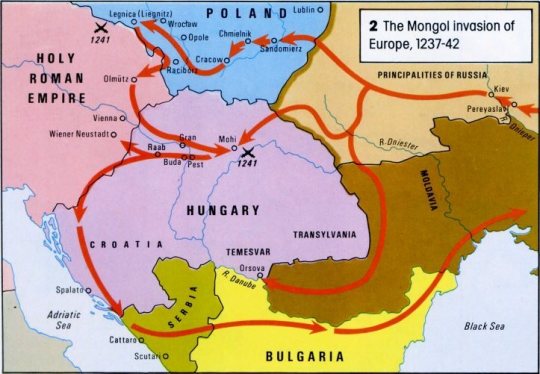
Frederick II, Holy Roman Emperor
“In 1241–1242, the forces of the Golden Horde decisively defeated the armies of Hungary and Poland and devastated their countryside and all their unfortified settlements. King Béla IV of Hungary appealed to Frederick for aid, but Frederick, being in dispute with the Hungarian king for some time (as Bela had sided with the Papacy against him) and not wanting to commit to a major military expedition so readily, refused. He was unwilling to cross into Hungary, and although he went about unifying his magnates and other monarchs to potentially face a Mongol invasion, he specifically took his vow for the defense of the empire on "this side of the Alps."

”Frederick was aware of the danger the Mongols posed, and grimly assessed the situation, but also tried to use it as leverage over the Papacy to frame himself as the protector of Christendom. While he called them traitorous pagans, Frederick expressed an admiration for Mongol military prowess after hearing of their deeds, in particular their able commanders and fierce discipline and obedience, judging the latter to be the greatest source of their success. He called a levy throughout Germany while the Mongols were busy raiding Hungary. In mid 1241 Federick dispersed his army back to their holdfasts as the Mongols preoccupied themselves with the lands east of the Danube, attempting to smash all Hungarian resistance. He subsequently ordered his vassals to strengthen their defenses, adopt a defensive posture...A chronicler reports that Frederick received a demand of submission from Batu Khan at some time.”
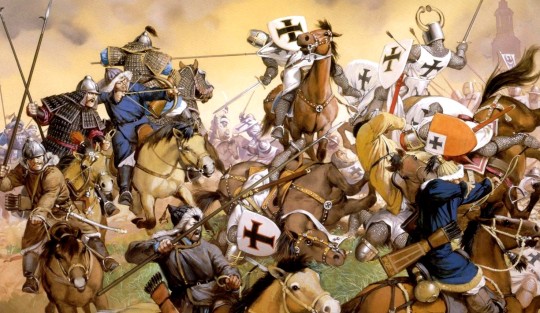
“A letter written by Emperor Frederick II, found in the Regesta Imperii, dated to June 20, 1241, and intended for all his vassals in Swabia, Austria, and Bohemia, included a number of specific military instructions. His forces were to avoid engaging the Mongols in field battles, hoard all food stocks in every fortress and stronghold, and arm all possible levies as well as the general populace.
Mongol probing attacks materialised on the Holy Roman Empire's border states...A full-scale invasion never occurred, as the Mongols spent the next year pillaging Hungary before withdrawing. After the Mongols withdrew from Hungary back to Russia, Frederick turned his attention back towards Italian matters.”

Pope Innocent IV
“In 1245, Innocent IV issued bulls and sent an envoy in the person of Giovanni da Pian del Carpine (accompanied by Benedict the Pole) to the "Emperor of the Tartars". The message asked the Mongol ruler to become a Christian and stop his aggression against Europe. The Khan Güyük replied in 1246 in a letter written in Persian that is still preserved in the Vatican Library, demanding the submission of the Pope and the other rulers of Europe...two Mongolian envoys to the Papal seat in Lyon, Aïbeg and Serkis. In the letter Guyuk demanded that the Pope appear in person at the Mongol imperial headquarters, Karakorum in order that “we might cause him to hear every command that there is of the jasaq”.
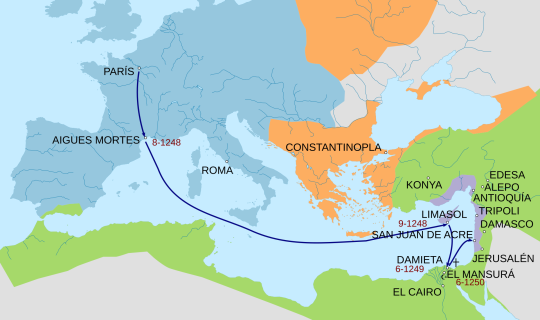
Seventh Crusade
“In 1244, the Khwarezmians, recently displaced by the advance of the Mongols, took Jerusalem on their way to ally with the Egyptian Mamluks. This returned Jerusalem to Muslim control, but the fall of Jerusalem was no longer a crucial event to European Christians, who had seen the city pass from Christian to Muslim control numerous times in the past two centuries. This time, despite calls from the Pope, there was no popular enthusiasm for a new crusade. There were also many conflicts within Europe that kept its leaders from embarking on the Crusade.”
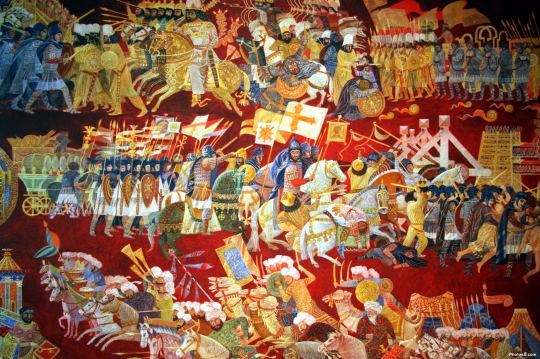
“Pope Innocent IV and Frederick II, Holy Roman Emperor continued the papal-imperial struggle. Frederick had captured and imprisoned clerics on their way to the First Council of Lyon, and in 1245 he was formally deposed by Innocent IV. Pope Gregory IX had also earlier offered King Louis' brother, count Robert of Artois, the German throne, but Louis had refused. Thus, the Holy Roman Emperor was in no position to crusade. Béla IV of Hungary was rebuilding his kingdom from the ashes after the devastating Mongol invasion of 1241.”
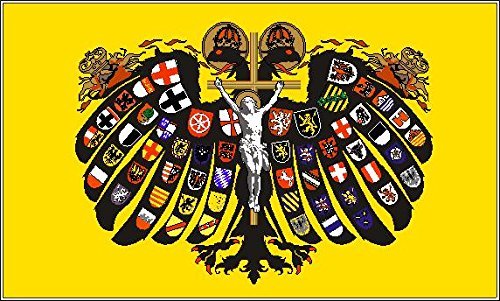
Interregnum (Holy Roman Empire)
“The term Great Interregnum is occasionally used for the period between 1250 (death of Frederick II) and 1273 (accession of Rudolf I)...After the deposition of Frederick II by Pope Innocent IV in 1245...in 1273, Rudolf I of Germany, a minor pro-Staufen count, was elected. He was the first of the Habsburgs to hold a royal title, but he was never crowned emperor. After Rudolf's death in 1291, Adolf and Albert were two further weak kings who were never crowned emperor...Sigismund (r. 1411 – 1437) was crowned emperor in 1433, but only with Frederick III (r. 1452 – 1493), the second emperor of the House of Habsburg, did the Holy Roman Emperor return to an unbroken succession of emperors (with the exception of Charles VII all of the House of Habsburg) until its dissolution in 1806.”

Franco-Mongol alliance
“European attitudes began to change in the mid-1260s, from perceiving the Mongols as enemies to be feared, to potential allies against the Muslims. The Mongols sought to capitalize on this, promising a re-conquered Jerusalem to the Europeans in return for cooperation. Attempts to cement an alliance continued through negotiations with many leaders of the Mongol Ilkhanate in Persia, from its founder Hulagu through his descendants Abaqa, Arghun, Ghazan, and Öljaitü, but without success. The Mongols invaded Syria several times between 1281 and 1312, sometimes in attempts at joint operations with the Franks, but the considerable logistical difficulties involved meant that forces would arrive months apart, never able to coordinate activities in any effective way...the Egyptian Mamluks successfully recaptured all of Palestine and Syria from the Crusaders.”
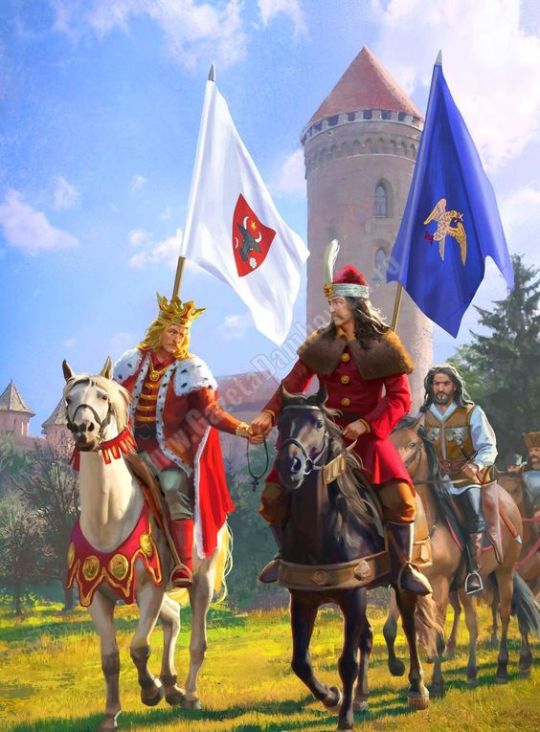
“Christian kings began to prepare for a new crusade (the Seventh Crusade), declared by Pope Innocent IV in June 1245 at the First Council of Lyon. The loss of Jerusalem caused some Europeans to look to the Mongols as potential allies of Christendom, provided the Mongols could be converted to Western Christianity. In March 1245, Pope Innocent IV had issued multiple papal bulls, some of which were sent with an envoy, the Franciscan John of Plano Carpini, to the "Emperor of the Tartars". In a letter now called the Cum non solum, Pope Innocent expressed a desire for peace, and asked the Mongol ruler to become a Christian and to stop killing Christians. However, the new Mongol Great Khan Güyük, installed at Karakorum in 1246, replied only with a demand for the submission of the pope, and a visit from the rulers of the West in homage to Mongol power:”

Hohenstaufen
“The Hohenstaufen also known as Staufer, were a dynasty of German kings (1138–1254) during the Middle Ages. Before ascending to the kingship, they were Dukes of Swabia from 1079. As kings of Germany, they had a claim to Italy, Burgundy and the Holy Roman Empire. Three members of the dynasty—Frederick I (1155), Henry VI (1191) and Frederick II (1220)—were crowned emperor. Besides Germany, they also ruled the Kingdom of Sicily (1194–1268) and the Kingdom of Jerusalem (1225–1268) [succeeded by the House of Habsburg in 1268]”
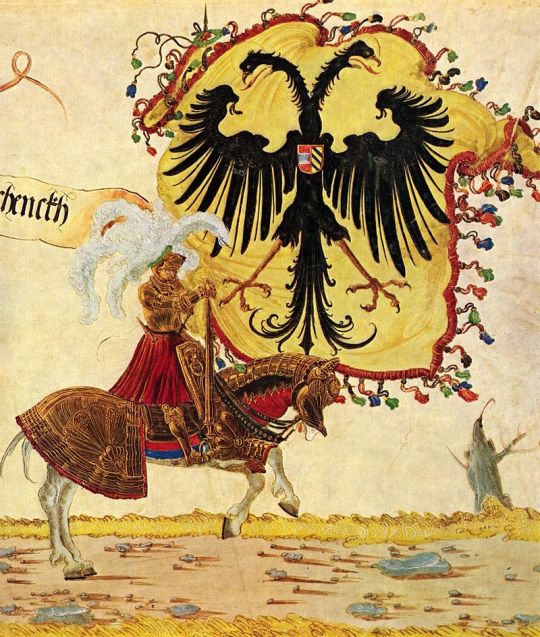
House of Habsburg
“The House of Habsburg and alternatively called the House of Austria was one of the most influential and distinguished royal houses of Europe. The throne of the Holy Roman Empire was continuously occupied by the Habsburgs from 1438 until their extinction in the male line in 1740. The house also produced emperors and kings of Bohemia, Hungary, Croatia, Galicia, Portugal and Spain with their respective colonies, as well as rulers of several principalities in the Netherlands and Italy.”

“The Habsburg Empire was never composed of a single unified and unitary state as Bourbon France, Hohenzollern Germany, or Great Britain was. It was made up of an accretion of territories that owed their historic loyalty to the head of the house of Habsburg as hereditary lord. The Habsburgs had mostly married the heiresses of these territories, most famously of Spain and the Netherlands. They used their coats of arms then as a statement of their right to rule all these territories."
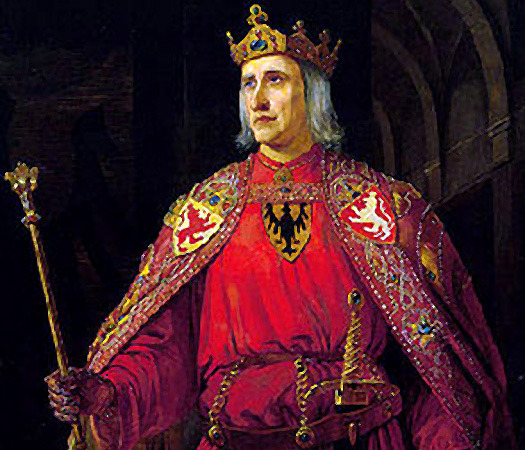
Rudolf I of Germany
“Rudolf I, also known as Rudolf of Habsburg was Count of Habsburg from about 1240 and King of Germany from 1273 until his death.Rudolf's election marked the end of the Great Interregnum in the Holy Roman Empire after the death of the Hohenstaufen emperor Frederick II in 1250.
The disorder in Germany during the interregnum after the fall of the Hohenstaufen dynasty afforded an opportunity for Count Rudolf to increase his possessions. His wife was a Hohenberg heiress; and on the death of his childless maternal uncle Count Hartmann IV of Kyburg in 1264, he also seized his valuable estates.”

Kyburg family
“Kyburg also Kiburg was a noble family of grafen (counts) in the Duchy of Swabia, a cadet line of the counts of Dillingen, who in the late 12th and early 13th century ruled the County of Kyburg, corresponding to much of what is now Northeastern Switzerland.The family was one of the four most powerful noble families in the Swiss plateau beside the House of Habsburg, House of Zähringen and the House of Savoy during 12th century. With the extinction of the Kyburg family's male line in 1264, Rudolph of Habsburg laid claim to the Kyburg lands and annexed them to the Habsburg holdings, establishing the line of "Neu-Kyburg", which was in turn extinct in 1417.”
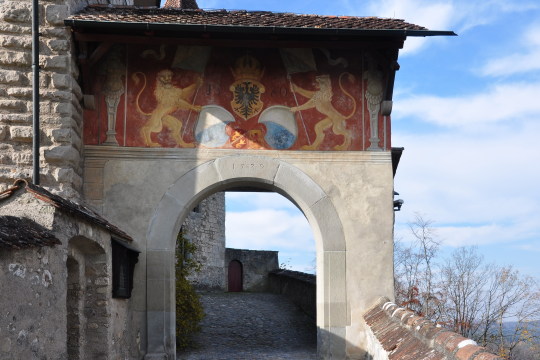
“In 1250/51 the childless Hartmann IV gave the western part of the property with the center of Burgdorf to his nephew Hartmann V. As a result, Hartmann V, who was supported by the Habsburgs, came into conflict repeatedly with the growing city-state of Bern. His uncle had to step in often to keep the peace. When Hartmann V died in 1263, Count Rudolf von Habsburg became the guardian of Hartmann's daughter Anna, and also took over the administration of the western section. In 1264, after the death of Hartman IV, Rudolf stepped in to control the eastern half as well. Though this brought him into conflict with the claims by the widow Margaret of Savoy and her family.”

”Anna, daughter of Hartmann V, married Eberhard I of Habsburg-Laufenburg. This marriage was intended to secure Habsburg interests in Aargau (Argovia) against Savoy. The son of Eberhard and Anna, Hartmann I (1275–1301) again called himself "of Kyburg". His line came to be known as that of Neu-Kyburg or Kyburg-Burgdorf, persisting until 1417.”

House of Borgia
“The House of Borgia was an Italo-Spanish noble family, which rose to prominence during the Italian Renaissance. They were from Aragon, the surname being a toponymic from the town of Borja, then in the Crown of Aragon, in Spain.The Borgias became prominent in ecclesiastical and political affairs in the 15th and 16th centuries, producing two popes: Alfons de Borja, who ruled as Pope Callixtus III during 1455–1458, and Rodrigo Lanzol Borgia, as Pope Alexander VI, during 1492–1503.”

Name of Turkey
“The English name Turkey, now applied to the modern Republic of Turkey, is historically derived (via Old French Turquie) from the Medieval Latin Turchia, Turquia. It is first recorded in Middle English (as Turkye, Torke, later Turkie, Turky), attested in Chaucer, ca. 1369. The Ottoman Empire was commonly referred to as Turkey or the Turkish Empire
The English name of Turkey (from Medieval Latin Turchia/Turquia) means "land of the Turks"...The phrase land of Torke is used in the 15th-century Digby Mysteries. Later usages can be found in the Dunbar poems, the 16th century Manipulus Vocabulorum ("Turkie, Tartaria")...The medieval Greek and Latin terms did not designate the same geographic area now known as Turkey. Instead, they were mostly synonymous with Tartary, a term including Khazaria and the other khaganates of the Central Asian steppe, until the appearance of the Seljuks and the rise of the Ottoman Empire in the 14th century...The Arabic cognate Turkiyya (Arabic: تركيا) in the form Dawla al-Turkiyya (State of the Turks) was historically used as an official name for the medieval Mamluk Sultanate which covered Egypt, Palestine, Syria, Hejaz and Cyrenaica.”

What’s the Word for Turkey in Turkish?
“The word for turkey in Turkish is hindi.What? OK, so what’s the Hindi word for turkey?Turns out that the word for turkey in Hindi is टर्की. And that, if you don’t know Devanagari, is transcribed ṭarkī in the Latin alphabet.
Turkeys are native to the Americas, but the Europeans first encountering them thought that they looked like a kind of guinea fowl, another large, ungainly, colorful-faced kind of bird. Now, guinea fowl were also called turkey fowl, but that’s because they actually had a legitimate connection to Turkey the country: Europeans received most of their guinea fowl imported via Turkey...the first turkeys brought to Europe also generally came via Turkey: The birds had originally been domesticated by the Aztecs and were brought to Europe by Spanish conquistadores, who traded them to the rest of the continent via North Africa.
Japanese and Korean call it the equivalent of “seven-faced bird,” Abkhazian and other languages in the Caucasus call it “blue bird,” and Thai and Urdu call it “elephant chicken” or “elephant trunk chicken.”

(via What’s the Word for Turkey in Turkish? | Slate)
#turkey#silkroad#chainofcommerce#noblemerchantclans#ambasadorsorspies#kiyat#borjigin#burji#borgia#borghese#kiburg#ghibelines#holyromanempire#rudolfofhapsburg#hapsburgdynasty#vladtheimpaler#transylvania#house of saxe-coburg and gotha#popeinnocentiv#guyukkhan#mongolultimatum#marriagealliance#tributetax#wagewarfortribute#secrethistoryofthemongols#doubleheadedeagle#goldenhorde#goldenorder
13 notes
·
View notes
Link
Finally, it is important to see the eastern slave trade in its proper context. To think of the Muscovites and Poles as nothing more than victims of the Tatars is to radically distort the truth. Muscovy, in particular, was frequently complicit, and the institution of slavery flourished for many years within its borders. This was a matter of special significance when it comes to explaining how it was possible for Finns to find their way to the Crimean market, for the truth is that they were mostly seized and sent there by Russians. The northern town of Novgorod – known during the middle ages as Novgorod the Great in deference to its wealth and power – was a key centre of the slave trade in this region, and the men of Novgorod are known to have mounted numerous raids into Karelia with the explicit purpose of capturing exotic Finnish children. Prisoners taken in this region were so valuable, indeed, that after the incorporation of the Khanate of Astrakhan into the growing Muscovite empire, the son of its former khan was permitted to lead two expeditions through Muscovy to launch raids in Karelia (1555 and 1577), while Shah Abbas of Persia sent delegations that managed to acquire three Finnish girls in Moscow and 30 more in Kazan.
---
taas kirjoittaja ajattelee että Novgorodin Karjala oli suomalaisaluetta vaikka karjalainen kulttuuri oli jo kehittynyt...
----
According to Jukka Korpela, the chronicles of the medieval period record major raids into Karelia on average once every 10 years between the mid-14th and early 16th centuries, “which is a very high frequency in view of the fact that this area lay outside the interests of the late medieval realms.” Some were mounted by private enterprise – notably “marauding boatmen” from Novgorod. Others were sponsored by local rulers who hoped to profit handsomely from them.
The earliest records that we have of Muscovite raids in this region date to 1477, the year before Novgorod fell to Tsar Ivan the Great. An account dating to 1490 gives more detail about the specifics of the trade: the Russians plundered the parish of Kemi, in northern Finland, kidnapped its women and children, and offered them for ransom. Some families paid to recover their relatives; most could not, and lost them to slavery. When Tatar troops from Astrakhan mounted their similar raid in 1577, they left children too young to walk out on the ice to die.
---
Kemi löytyy myös Vienan Karjalasta...
12 notes
·
View notes
Photo

Cathedral of St. Vasily the Blessed, Moscow (Russian postcard before 1917)
The Cathedral was a public museum during the Soviet period. On October 14, 1991, St. Basil’s Cathedral was reopened for church services after six decades of being barred from hosting religious rites.
Those wild colors are more newfangled than you might think... the cathedral used to be white and its domes were gold. Up until the late 19th century, the Kremlin was painted white, and the Cathedral matched. The red brick and multicolored decorations are a more recent addition, with the current paint scheme created in 1860.
img source: Храм Василия Блаженного
The architecture is still kind of a mystery. How architects in the 16th century had figured out how to build such a complex, many-spired structure without design drawings was an enigma for centuries. But in 1954-1955 – notably, soon after Stalin’s death in 1953 and at the start of Khrushchev’s reforms – the historical landmark was restored, at which time the trick behind the architecture became clear. Restorers observed that the walls of the building had been outlined with thin timbers before all the ornamentation went up – a trick that basically gave a three-dimensional blueprint. Working from that image for what the completed structure would look like was a handy guide for the bricklayers.
It’s a church with a military background. Ivan IV (also known as “The Terrible”) commissioned the church to commemorate Russia's victory in Kazan’ and Astrakhan, one of the first major victories restoring Russian land from the Kazan Khanate (1552-1554). St. Basil, known as a “holy fool,” was perhaps the only person to stand up to Ivan the Terrible about the lives lost under his rule, and is rumored to be the one thing Ivan feared. And the building’s bloody background doesn’t end there. Popular legend has it that after the cathedral was completed, Ivan IV ordered for the architect to be blinded so he could never complete a work of comparable beauty. Exactly who that architect was and whether the story is true, however, remains a mystery.
Five Wild Facts about St. Basil's Cathedral
#moscow#church#red square#Russian Empire#orthodox christianity#orthodox#Christianity#ivan the terrible#16th century#imperial russia#saint basil's cathedral#postcard#mu photo#mu
2 notes
·
View notes
Text
Decided to ask a few blunt questions prefaced with explanation of my own logic in asking them:
Today, because I feel like lobbing a firebomb into discussions (and more bluntly because of all that reading on the Mongol Empire in women's history) I'd like to make a point on how decolonization in practice would get rather snarled if it was taken into some of the areas it can go. There are four parts of Europe that saw major colonial eras in medieval times (and in the Irish case lasting all the way to the 20th Century). Ireland, Iberia, Russia, and the Balkans. Before that the Roman Empire and its medieval transformation into the Byzantine marked that as well and that means the Balkans had a very short-term interlude between Byzantine and Ottoman Empires where the Bulgarians and Serbians tried and failed to build states and got ground under the mills of far more powerful imperial civilizations.
In the specific cases of Iberia and Russia we have the major cases of non-white, non-Christian cultures that ruled parts of Europe. This is one take on it I see a great deal of in a recurring meme based on a Tumblr post. Yes, this is true. Batu Khan and Tariq ibn Zayid got it that by conquest in a ruthless fashion not unlike that of modern European imperialism in the rest of the world. These cultures, Al-Andalus and the Golden Horde, are not peaceful hippie exchange situations, they were the vanguards of world empires and frankly the relative fringes that were still exceptionally powerful in European terms. The Golden Horde left multiple successor states, the Grand Principality of Moscow, and the Khanates of Crimea, Astrakhan, Khazan, and Siberia. Al-Andalus kept bouncing back until Las Navas De Tolosa when it spent the remaining centuries as the friendly neighborhood Emirate of Granada until the Catholic Monarchs were bored with that and fought a war for ten years to destroy it.
That means that we do have realities where parts of Europe were colonial subjects. And those parts that were went onto build world empires. The Grand Principality of Moscow built a state that spanned a sixth of the world and is still a geographically massive state with 144 million people. Spain built an empire spanning multiple continents, the Americas, Asia, Africa, the Pacific. These are not unconnected, and the myth and the self-perception of the Tatar and the Muslim Yokes have done much to shape the aggrieved victimhood of Russians and Spanish, and the concept that everything bad about their culture the dirty foreigners did, everything good they did.
And yet there is also the point that is true that no small amount of what's bad in the Global South IS the direct result of imperialists forcing things on cultures that might have had other bad points without it under their own control but didn't. To what point can it be said in the 2020s that the experiences of the 19th and 20th Century empires deserve blame for bad actions? Does that mean that the Mongols and the Caliphate should somehow be given a pass for centuries of imperial power and it be pretended that all the imperialist nonsense of 'found X brick and left it marble' becomes true in Arabic and Mongolian?
No. The truth is that these were products of aggressive imperial states. The truth is also that it's not so much what empires do as what they are believed to have done that underlines the self-perception of new states. The Tatar Yoke did not create all the pathologies of the new Russian state. It shaped aspects of Russian autocracy and it explicitly made Moscow's rise inevitable and belatedly began to realize that this might be a bad thing by which time it was too late to prevent it. Al-Andalus created the frontier myth and the aggressively militarized Christianity of Spain that played its part in the medieval Aragonese Empire and Conquistador rampages all over the world.
So how would one apply the logic of decolonization in these cases, and what does it say that as with the PRC that experience of colonialism only inclines those states that can to repay with compound interest what was done to them?
#lightdancer comments on history#decolonization#mongol empire#khanate of the golden horde#umayyad caliphate#al-andalus#it is kind of grimly funny to see all those 'plenty of non-white people in Europe' posts that neglect how these people actually got there#was that any different to Crusader attempts at imperialism in the Middle East? No#that's kind of the point#sometimes cultural exchange was fairly pacific merchant colonies in ports#sometimes it was a warlord who said 'this is my land now and I'll kill as many of you as I have to keep it'
0 notes
Text
Siberian History (Part 7): Mangazeya
The Russian frontiersmen in Siberia still had to depend on Moscow for support (such as administrative & logistical support). During the Time of Troubles, the Siberian garrison was mostly left to themselves, which lead to disease, starvation and death.
The natives peoples of Siberia took the opportunity to make several attempts at an uprising. The most powerful was in 1608, when Princess Anna of Koda, a “Tartar Joan of Arc”, nearly succeeded in uniting the entire native population of Western Siberia to revolt.
In 1612, an attempt was made to re-establish the old Khanate of Sibir “as it had been in the time of Kuchum”. But it was betrayed at the last minute, and ten of its ringleaders were rounded up and hanged.
By now, the Russian occupation of the Ob-Irtysh Basin had increased the nation's size by a third. But in Moscow, Siberia still wasn't properly understood as a geographical entity, and so it was used as a political bargaining chip.
Boris Godunov, for example, tried get an influential boyar to support him against False Dmitry I, by promisng him “the Kingdoms of Kazan, Astrakhan, and all Siberia”. The False Dmitry II promised to reward his brother-in-law, a powerful Polish noble, with “the whole land of Siberia” for his help.
But the Ob-Irtysh Basin had scarcely been secured before the Russian advance into the next great river valley, the Yenisei, began.


The Russians ascended the eastern tributaries of the Ob River, and crossed a low plateau to streams flowing into the Yenisei. By 1619, they had taken all the important river routes and portages that connected those two rivers. They organized expeditions from Mangazeya (in the north) and Tomsk & Ketsk (in the south), coming at the river valley from both directions.

The Taz Estuary marks the area where Mangazeya was located.
They met the Tungu people on the lower Yenisei, and the Buryats (whom they'd never heard of before) on the upper Yenisei. The Buryats lived in a region that was rich in furs, and they practised animal husbandry; they were rumoured to grow crops and have access to silver. This was guaranteed to interest Russia.
The Tungu people (east of the Yenisei) and the Buryats (around Lake Baikal) fought to prevent Russia from establishing bases in their territory, but failed. Yeniseysk was founded in 1619 (where the Angara and Yenisei Rivers meet); Krasnoyarsk was founded in 1627 (astride cliffs of red-coloured marl); and Bratsk was founded in 1631 (on the Angara River).


On the upper Yenisei River (the southern part of it), the Russians met the staunch resistance of the Kyrgyz people and the Kalmuks, both steppe nomads. Their homelands bordered Siberia to the south, and they were continually hostile. Eventually, a solidly-fortified line was established over the southern frontier, but this would take two centuries.
Meanwhile, Russian mariners had developed the sea route north of Russia from Arkhangel to Mangazeya (which was just a few miles above the Arctic Circle). At Mangazeya, they bartered goods with the local Khanty and Samoyedic peoples for furs. Mangazeya prospered and grew, attracting more and more traders, who were willing to navigate the treacherous waters of the Kara Sea.
One contemporary account says that: “Hundreds of thousands of sable, ermine, silver and blue fox skins, and countless tons of precious mammoth and walrus ivory” were shipped every year from Mangazeya and Europe. This was an illicit trade that had begun during the Time of Troubles, and the government couldn't manage to gain control of it.
Porcelain, silk, and other expensive fabrics were traded (through middlemen) from Central Asia & China to Mangazeya. The city was “a virtual Baghdad of Siberia, where big commercial deals were celebrated at fabulous feasts that lasted for days, and that featured the best European wines and local delicacies like sturgeon, caviar, mushrooms, berries, and venison and other game.”
By the time stability was restored in Moscow, reports of Siberia's vast wealth in furs had spread far and wide. This, of course, attracted the attention and greed of European powers who wanted new colonies. The Russian government worried that foreign agents might try to trade directly with the natives, or even attempt an armed invasion (through the Taz Estuary) to seize the whole of north-western Siberia.
Meanwhile, inland merchants working out of the Urals, Tyumen and Tobolsk were envious of Mangazeya, as it siphoned off commerce that would otherwise have come to them.
So in 1619, the Russian government closed the sea route to Mangazeya. They forbade even Russians to use it, in case foreigners found it out from them. Anyone who broke this law was to be “put to the hardest possible death, and all their homes and families destroyed branch and root”.
Navigational markings were torn up. Surveillance posts were established along the coast, to intercept and kill anyone who tried to get through. A coastal fort was built on the Yamal Peninsula, commanding the portage between the Ob Gulf and the Kara Sea. Maps were falsified to depict Novaya Zemlya as a peninsula, rather than an island. This would cause problems for later mariners who were using them as nautical guides.
Gradually, Mangazeya declined, and the rich merchants left. In 1643, its administrative apparatus was moved to Turukhansk – this city was founded at the mouth of the Turukhan River, a tributary of the Yenisei. For a while, it was known as “New Mangazeya”.
In 1678, Mangazeya was burned to the ground, without any official explanation. The local Samoyedic peoples called its ruins Tagarevyhard, which means “destroyed town”. The site wouldn't be rediscovered for almost three centuries.
Mangazeya, perhaps more than any other early settlement, was the proof of the enormous wealth that Siberia possessed. In 1632, a former military governor of the district strongly encouraged the tsar to press on from the Yenisei to conquer the Lena River Basin. His encouragement was inspired by the riches of Mangazeya.
#book: east of the sun#history#military history#colonialism#economics#trade#native siberians#tungu people#buryats#kyrgyz people#kalmuks#khanty people#russia#khanate of sibir#siberia#yeniseysk#krasnoyarsk#bratsk#mangazeya#turukhansk#boris godunov#false dmitry ii
36 notes
·
View notes
Text
Foods of Russia

In short, Russian cuisine can be divided into four main eras:
Old Russian cuisine (9th-16th centuries);
In the medieval period most Russian beverages turned national: mead, khmel, kvass, cider. Beer appeared in 1284. In 1440-1470s Russia discovered vodka made from rye grain. Until the 17th century milk and meat were not popular. Meat boiled in shchi (cabbage soup) or for kasha was not even roasted until the 16th century.
Old Moscow cuisine (17th century):
Starting with Peter the Great, Russian nobility borrowed some of West European culinary customs and traditions. Rich nobles who visited countries in Western Europe brought foreign chefs with them to expand their repertoire. It was at this time that minced meat was introduced into Russian cuisine: chops, casseroles, pates and rolls became quite popular, along with non-Russian (Swedish, German, French) soups, which appeared in the 17th century: solyanka, (beef soup) and rassolnik (potato and pickle soup) containing brines, lemons and olives appeared at the same time and were hppily integrated into the cuisine. It was during this period that such well-known delicacies as black caviar and salted, jellied fish appeared.
In the 16th century Kazan and Astrakhan Khanates along with Bashkiria and Siberia were annexed to Russia. New food products such as raisins (grapes), dried apricots, figs, melons, watermelons, lemons and tea made their first appearance, much to the delight of the populace. During the short growing season, even poor farmers could enjoy a variety of fresh fruits, along with drying them for the long winter months. Foreign chefs cooked their national dishes, which harmoniously fitted in Russian cuisine. There was also the time of German sandwiches, butter, French and Dutch cheeses.
Petersburg cuisine (end of the 18th century-1860s)
The French expanded the assortment of starters by adding a number of old Russian meat, fish, mushroom and sour vegetable dishes the variety of which can be a surprise for foreigners. Because cold weather could last as long as nine months in some regions, preserved foods were a large part of Russian cuisine, and households would store as much food as possible to last through the long winters. This included smoking, salting, soaking, and fermenting. Cabbage could be used all winter to make shchi, or be used as a filling for dumplings. Soaked apples were often served to guests or in some side dishes. Pickled cucumbers were a main ingredient in many dishes, including several traditional soups. Salted and dried meat and fish were eaten after religious and pre-holiday fasts. Overall, it was a pretty spartan diet, with most economic groups using what was available.
Traditional Russian foods are heavily influenced by filled dumplings, hearty stews, soups, potatoes and cabbage:
+Borscht one of Russia's best-known foods, a chunky, cold stew made with beets and topped with sour cream
+Beef Stroganoff - strips of beef sauteed in a sauce of butter, white wine, sour cream (called 'smetana' in Russia), mustard and onions; eaten either straight or poured over rice or noodles
+Sweet-and-Sour Cabbage - cooked in red wine vinegar, applesauce, butter and onions.diced apples, sugar, bay leaves
+Solyanka Soup - a hearty soup made from thick chunks of beef and/or pork, cooked for hours over a low flame with garlic, tomatoes, peppers and carrots
+Golubtsy.- Shredded or minced beef wrapped in cabbage and steamed/boiled until cooked; found all over Eastern Europe
+Olivie. - a kind of potato salad made with pickles, eggs, bologna and carrots mixed with mayo
+Blini - thin, crepe-like pancakces topped with savory or sweet toppings like minced beef, caviar, or apples
+Potato Okroshka.- cold soup made from buttermilk, potatoes and onions, garnished with dill; Vichyssoise (often attributed to the French, it was actually created at the Ritz Carlton in NYC in 1917 but of course disputed by French chefs, who insist they created it)
+Knish - mashed potatoes, ground beef, onions and cheese filled inside thick dough pastry and deep fried/baked
+Khinkali - dumplings of ground beef and cilantro
+Khachapuri - thick, crusty bread shaped like a boat and filled with a variety of melted cheese
+Zharkoye - a beef stew made with potatoes, carrots, parsley, and celery, spiced with garlic, cloves, and dill; served hot with sour cream
+Pelmeni - dumplings made from thin, unleavened dough, filled with minced meat, mushrooms and onions
+Shashlik - classic shesh kebab
+Tula Gingerbread - similar to our gingerbread, but may contain jam or nuts
+Pirozhki - pastries filled with meat, potatoes, cabbage or cheese, similar to Polish pierogi
+Morozhenoe (rich ice cream); well hey... now you're talkin'
+Chak-Chak (Russia's attempt at funnel cakes... would we make that up?)
You'll notice a distinct absence of fresh vegetable salads, seafood, pasta and rice.They are just not part of their basic diet. And of course Russia is certainly not known for their desserts. Even Chicken Kiev is generally credited to several NYC restaurants who claim they created it, not to any native Russian chef or restaurant. (gee... you can't believe anything these days).
So next time you get a hankering for some borscht or a kinkali, you just may have to whip it up yourself. There is not a preponderance of Russian restaurants anywhere in the U.S. nor the desire for them. Few people thnk of blinis or knish when planning Sunday dinner. But who knows? You might just discover a whole new world of cuisine when you stick your toe in the Russian diet (oh dear, that didn't come out right). Go for it.
1 note
·
View note
Photo

On 25th of #August 1530 Ivan IV Vasilyevich aka Ivan the Terrible was born. Grand Prince of Moscow from 1533 to 1547 and Tsar of All the Russias from 1547 until his death. His long reign saw the conquest of the Khanates of Kazan, Astrakhan, and Siberia, transforming Russia into a multiethnic and multiconfessional state spanning almost one thousand million acres, approximately 4,046,856 km2 (1,562,500 sq mi). Managed countless changes in the progression from a medieval state to an empire and emerging regional power, and became the first ruler to be crowned as Tsar of All the Russians. #painting "Ivan the Terrible and His Son Ivan" by Russian realist artist Ilya Repin #picassaus #fineart #art #artist #contemporaryart #avantgraff #artoninstagram #royal #history #ivantheterrible #russia #tsar #ilyarepin #Росси́я #Ива́нВаси́льевич #drawing https://www.instagram.com/p/CETOkd0lT_k/?igshid=13n256uyev9lk
#august#painting#picassaus#fineart#art#artist#contemporaryart#avantgraff#artoninstagram#royal#history#ivantheterrible#russia#tsar#ilyarepin#росси́я#ива́нваси́льевич#drawing
0 notes